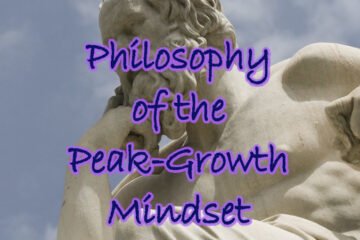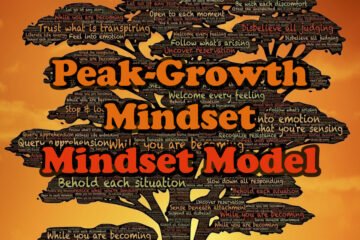
Peak-Growth
This article describes a state of peak-growth, or peak-learning, which can be attained as part of an individual’s self-transcendent journey. It represents a very high level of attainment, and it means that the system of the mind has attained a peak of processing ability, and of flow.
Peak-Growth is a term we have adopted to describe a mental state where an individual is able to process the moment, and see the “lesson” or benefit of the moment, within each moment.
This means that there is rarely anything left to process from that moment in any of the following moments, and the state of being in-the-moment, with gratitude, can be sustained to it’s maximum, and peace of mind, as well as balance, maintained indefinitely.
Peak Growth does not mean that one has arrived at any kind of maximum rate of learning and awareness expansion. Rather, it means that the basic set of tools have been correctly implemented in order that a highly efficient processing system has been created in one’s mind. This, is a starting point, not a place where one’s growth, or rate of growth, is limited.
Components of Peak Growth
To attain peak growth, one has to master a number of individual skills, and apply them together, in order for peak growth to be arrived at.
Living in the Now
Living in-the-moment, or in the now, means that one’s full attention is deployed on the moment in hand. It means that our focus has not drifted into past events or future possibilities. Our emotions are free to express whatever is felt, right now, and they do not include memories of past experiences, or future concerns.
What is a moment?
For the sake of this article, and the concept being discussed, we should make clear that a “moment”, is more of a transaction. For example, a moment may start when I ask you a question, and that moment may not end until you have produced a response.
If you think about that flow, then you might see there is, time to listen to the question, time to process it, and then time to respond to it.
To be in that moment, and in the flow of that moment. It is critical that the individual is able to carry out all of those operations within a self-set time period, based on the perceived patience of the person asking the question.
If, for example, the questioner prompts for the answer before the individual has fully thought it through, then they may blurt out an improper response, and blame themselves for it. Or they may become so anxious, anyway, that they lose concentration and find themselves having to ask for the question again. But if they were able to complete that thinking within that correct time, then there is no anxiety to carry over to the next moment, no sense of failure.
“This aligns closely with what we see when the nervous system is no longer allocating predictive bandwidth to constant threat anticipation. Once the “coping architecture” begins to quiet, neural efficiency improves, pattern recognition, creativity, and integrative thought can flourish again. What you’re describing is such a clear example of the system reclaiming precision once chronic defence loops release.”
Maximising thinking time
Clearly, in order to be at peak performance, we need to be able to use as much of the time available in order to arrive at our best response. We do not want to be bearing anything else in mind. We do not want to have our judgement clouded by worries or concerns based on past or future events, as I have already suggested. However, there are subtle ways that such influenced can become inserted into one’s thinking, causing processing delay.
Coping thoughts that slow you down: Coping thoughts are things we teach ourselves to think, to apply in each moment, in order to keep us safe. For example, we may need to check if the question is likely to trigger us, before we really want to hear it. That check alone, depending on how efficiently it has been constructed, can be the cause of significant processing delay.
Coping thoughts and Cognitive DNA
Anyone that has read my E-Book, Training the Ego, will know that I have a simplistic view of the Ego, as an automated self learning system, that can retain and repeat learnt behaviours, automatically, and much more efficiently than if one needs to think an activity through. I use the analogy of learning to ride a bike, where, over time, the process of riding the bike becomes more and more effortless – you need to think and actively control your body less and less as the new learning simply becomes an on-demand automatic response. This allows you the thinking time to appreciate your wider environment more, and turns a once awkward activity into a natural flow.
However, coping thoughts do not always make it in our cognitive DNA. This is often the case, in terms of coping thoughts inspired by trauma, especially repeated trauma. Black-and-white thinking often plays a large part of this. An efficient coping technique deals specifically with the actual problem, in order to minimise the coping technique’s likelihood of having “side effects”, that cause the organism of self greater overall distress than the abuse the individual is trying to avoid.
However, repeated trauma or abuse often results in such decisions as “Never be yourself”, “All women/men hate me”, “When I go out, I will always be attacked”. Such decisions often result in huge, coping techniques that can introduce a massive checklist for every new moment that such judgements are to be applied. This can often take up all of our thinking time. They won’t go to DNA, and they can make almost every moment a person is in that situation, overwhelming, to the point of fight or flight.
It can be seen, then, that whilst broad ranging coping techniques may well help initially, unless we carefully manage them, and make sure we prune them as much as possible, then they can in themselves cause us to lose significant ability to deal fully with each new now moment.
The Happy Dance
Clearly it would be good if we could adopt a mental attitude that minimises the chances of us perceiving each now moment as a threat, or as always likely to be negative. We do not want to ignore threats, that would be dangerous, but, if we always, for every situation, look at both the good and the bad sides, and always the good side first, then that positive potential makes us much more tolerant and accepting of any negative aspects, discovered later. If you can think yourself happy, you will also think faster, and have less processing delay. Negative thinking is also slow thinking, as it encourages the creation of more and more coping thoughts.
Gratitude
We have a great page on gratitude, I suggest you read it. Gratitude is another key component for Peak Growth. It may not sound like it, but gratitude is a key underpinning strength, to allow a more easy flow of thoughts and experiences. Gratitude has strong influence on a person’s Window of Tolerance. Every time a person genuinely appreciates something and feels gratitude for that thing, then the higher the individual’s Window of Tolerance will be, and that individual will be more resilient to the challenge of every new moment.
Gratitude in-the-moment
As part of our work towards Peak Growth, the ambition is to arrive at a state where gratitude becomes automatic for every new moment, because we are also dancing that Happy Dance, and looking for the good stuff first. All you have to do, is keep practicing, keep seeking the good first, and give gratitude as soon as it is found, after some time, and with different experiences embodied, this will become automatic, part of one’s Cognitive DNA. This situation is often called flow state. However, there is still more to do, and the next part can take some time.
Masking and how it makes things a little complicated
The brain and the ego are really very clever. Together they realise that different situations require different rules of engagement and that also include those coping techniques and thinking styles that can be grouped together into a collection that we often call “Masks“. These masks can however, mean that one could find oneself with several hundred masks that each need to be assessed and updated. However, the mask only comes into operation when we are in the situation that the mask was designed for. This means that it could take quite a long time to go through each one, recreate the situation, modify the mask, and test it.
We can use mindfulness to monitor the mask in operation, and our own version of Exposure Therapy to carry out our testing. It is usual for a person to do this. However, ideally we would reduce our masking to the absolute minimum, and the only way to do that, is to be true-to-self, and never present a false self. The individual would, then, never need to remember which false version of self to present, and never need to remember which falsehoods and distortions were said in the last interaction in that situation. This lack of need to remember, it is golden, it is freeing, it is empowering like you could not imagine. It is when you can stand true to self, with no defences, it is then that you can attain peak growth.
This concept aligns with recent thinking in relation to the Human Nervous System under stress, and that by this method of removing toxicity, in order to allow the individual to drop their coping thoughts and behaviours, and therefore release any performance anxiety, in relation to the fear of not being able to respond in time, or understand the question.
Maskless operation
So how can a person discard their masks? Well, the secret is largely in the adoption of sound, clear logic. Socratic Questioning points the way to this. It points to an individual that has the common sense to ask for clarification rather than risk making an incorrect assumption. This allows for a much more detailed and nuanced understanding of the topic to be formed, whilst minimising any stress, because the risks have been minimised, automatically, as a natural part of one’s flow.
The nice thing is this: As you start that laborious process of reviewing your mask, the ego realises what is happening, and starts condensing the masks for you, and rather than visit several hundred masks, the ego starts using a default mask, and in a much quicker period of time, just the single mask remains, and even it, eventually, will fade.





0 Comments